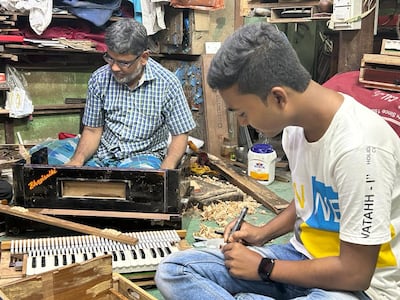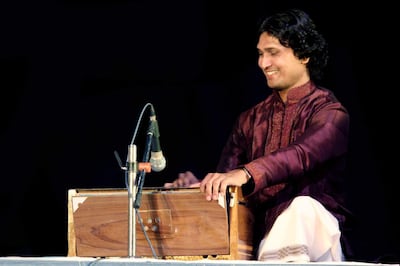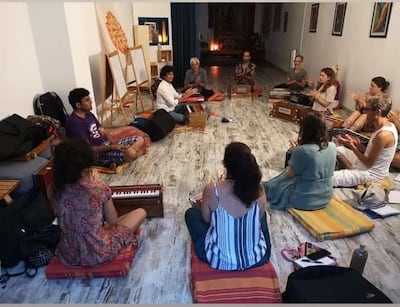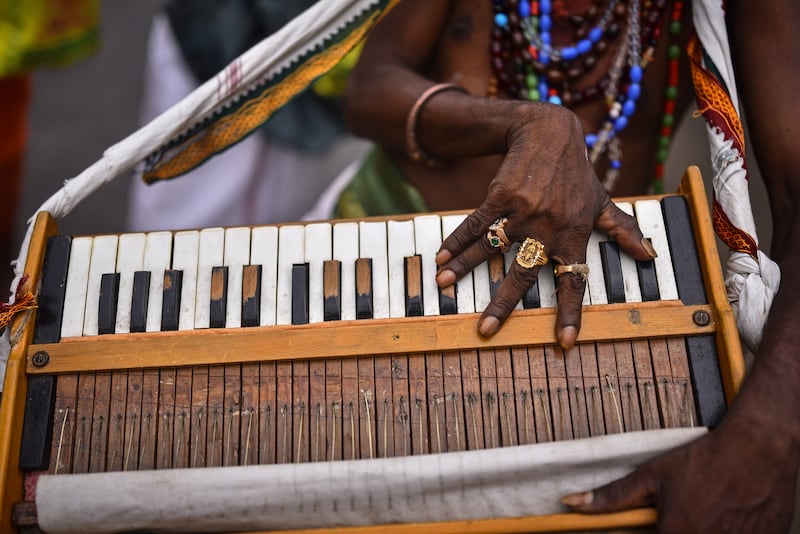The harmonium is an integral part of Indian music in every genre – from folk to Hindustani classical to Bollywood. It is also widely used in devotional music by Hindus, Muslims and Sikhs.
But not many people know that it is not actually from India. The keyboard instrument set in a box, which makes a sound by blowing air through reeds, was first patented in France in 1840 by an inventor called Alexandre Debain.
Unlike organs, which became warped on long sea voyages, the harmonium was portable and easy to carry.
“Brought to India by French missionaries in the 19th century, the harmonium took no time to blend beautifully into the warp and weft of the Indian music scene,” says writer and music historian Manek Premchand. “Its euphonious sounds have a universal feel to them, too, adding to its appeal.”
But at the height of the Indian independence movement, the harmonium faced banishment by anti-colonialists. Many orthodox music schools termed it a foreign instrument. Nobel laureate Rabindranath Tagore, the author of India's national anthem, called it “the bane of Indian music” and banned it in his residential school Shantiniketan.
All India Radio, which had a monopoly over radio broadcasting in India, even banned this instrument in 1940 for three decades.

“The attempt to banish the sound of the harmonium was part of an attempt to define a national sound for India, distinct from the West,” writes University of Minnesota ethnomusicologist Matthew Rahaim in his research paper That Ban(e) of Indian Music: Hearing Politics in The Harmonium, published in 2011.
The ban was lifted in 1971, in a limited way, when it was permitted to be used as an accompaniment, but not for solo performances.
Harmoniums were first manufactured in India in 1875 in Kolkata. Dwarkanath Ghosh was the first to make the versions of the instrument we are familiar with today.
European versions had foot-operated bellows and were used in theatre performances. They were later tweaked for seated performances with handpump bellows.
Slowly but surely, the harmonium started replacing many Indian instruments, such as the string-bowed sarangi, in concerts. The sarangi required a lot of effort to tune compared to the harmonium and was also associated with courtesans.
Around 1900, Jeevanlal Mistry from Palitana – a Jain pilgrimage town in Gujarat – started making harmoniums as a cottage industry. By 1915, India had become a leading manufacturer of the instrument.

In the past, the thin metal reed that is the soul of the harmonium had to be imported from Germany. Today, the best brass reeds are made in Palitana – they are known for their tonal qualities, craftsmanship and durability.
“As elites have struggled to cleanse modern Indian music of what they argue is a 'foreign' intruder, the masses have used the harmonium as a gateway to an understanding of their musical heritage,” writes Rahaim.
The harmonium’s decline in Europe began in the early 20th Century when the electronic organ came on to the market. Today, it is undergoing a revival thanks to interest in yoga and chanting.
In India, it became popular with ghazals or Urdu poetry set to music, and Kathak, the North Indian classical dance. It also became popular for qawwalis – a devotional Sufi music tradition that’s popular in North India.
It was also a popular instrument for teaching students the basics of music. Many famous Indian musicians like Begum Akhtar and Pandit Bhimsen Joshi were champions of the instrument and used it in their concerts.
Pakrashi & Co in Kolkata, situated on Rash Behari Avenue has been making harmoniums with silky teak surfaces and high quality reeds for over 100 years. Their instruments have been used by many famous musicians such as the Grammy-winning musician Zakir Hussain and maestros such as Salil Chowdhury and the late Ghazal king Jagjit Singh.

“The instrument is made in our workshop without any machines. It is entirely handcrafted and a team of three artisans work for 40 days to make four harmoniums. We use teak wood and reeds from Palitana and polish it using polyurethane,” explains Suvojit Pakrashi, the third generation owner of the store.
Pakrashi & Co export their instruments to more than 21 countries and also hold regular repair workshops around the world where musicians can get their harmoniums fixed and also pick up the art of maintenance.
Their most expensive harmonium costs 52,000 rupees (Dh2,328).
Santosh Ghante is one of the few artists who plays the harmonium solo and has done for the past 15 years – having performed in over 25 countries.
“I was always keen on making it as a solo player and unlike other harmonium players who aspire to accompany great maestros, I aspire to be a harmonium maestro myself,” he says.
Ghante has performed with heavy metal bands as well as in Bollywood and conducts workshops around the world.
“The harmonium is probably the most popular among the accompanying instruments in Hindustani classical music,” says classical vocalist Priya Kanungo. “It is an easier instrument to learn compared to, say, the sarangi, and when played judiciously, can raise the bar of a concert.”






